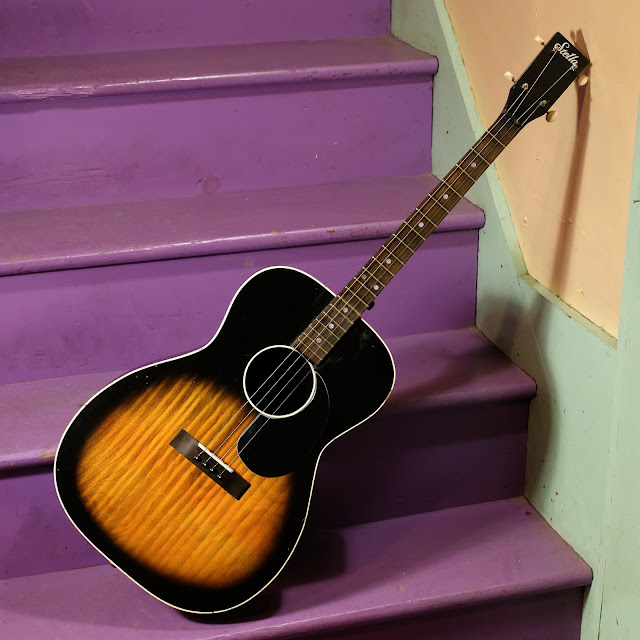1960s Harmony H929TG "Stella" Tenor Guitar
This 0-sized tenor is actually a fairly rare bird. I often see the fancier, spruce-and-mahogany Sovereign version of this instrument, but it's not often that I see this plain-Jane, all-birch version. It's an undeniably "cool" guitar and its owner even keeps it in proper, standard CGDA tuning.
While it'd originally come in just for setup-side work and to remove an overly-zealous shim-up under the fretboard extension, the truth is that it basically needed everything. In recent memory, this had been "gone over" by another repairman who'd apparently reset the neck, made and installed a replacement bridge and saddle, and set it up. All that work turned-out to be far from the truth, though.
To correct the ski-jump of the fretboard angling up over the body, I removed the 14th fret and then cut and removed the fretboard extension. As soon as the extension was off, I noticed that the neck felt loose and the joint looked really sloppy. I then took out the strap button at the back of the heel (and pointing into the neckblock) and the whole neck came out with a little wiggle. If that's a decent neck reset, then our stairs aren't purple. I went about resetting the neck with a lot of shim-ups in the joint and glued it and the fretboard extension in place. After taking the clamps off the next morning, I used the access of that old strap button hole to then install an additional internal screw/bolt for "good luck" and filled the old hole on the outside of the heel.
Next-up was a fret level/dress which also included some fret seating, too. When that was done I figured I just needed to string it up and adjust the saddle a little bit, as I'd reset the neck so that the previous repairman's saddle would match-up for 1/16" action height at the 12th fret. Since I usually compensate whatever saddle's on an instrument at the same time, I started making measurements to check what kind of profile I'd have to make on the saddle for it to compensate correctly. That floored me because I found out that while the previous guy had bothered to make a new bridge, he hadn't bothered at all to install it with the saddle in the correct location. It was off fully 1/4" to the rear. That'd play flat like mad all up and down the fretboard. It'd sound sick to the ears.
My "let's not charge the customer a whole ton to solve this" solution for that involved filling the old saddle slot, cleaning-up the bridge's look, and then cutting a new slot in the front of the bridge to accept a new saddle. The proper spot for the saddle to be was with the high string at 22 3/4" from the nut -- which placed it at the leading-edge of the bridge. So, I did my cutting and then made a new bone saddle that fits in that slot in the bridge and mounts with two small screws. I had to do something similar on an old Bruko quart guitar in 2017, but this tenor's saddle is a bit more serious. It looks a little akward but it works.
Fortunately, everything turned-out fine and now the guitar both sounds excellent and plays like a champ, too. I have 32w, 22w, 14, 10 gauges on it, the neck is straight, and it plays with 1/16" action at the 12th fret.
The pearl dots in the ebonized maple board are not original and were added by the last repairman.
The top of the saddle is compensated for CGDA tuning.
The strap button moved from the back of the heel to the side of it after work was done.












Comments
Nice work. I have a similar tenor of early vintage that has the brand name of "Supremo". I'm just wondering if anyone has heard of the brand or anything basically about the history of the brand would be appreciated. I bought the guitar at a Goodwill style auction in Ontario, Canada and had a new bridge constructed for the guitar and now it's playable. It looked so forlorn and ignored when I first saw it that I had to make it sound again. Photos available on request. Thanks.
Regards, Steve Aykroyd, Canada